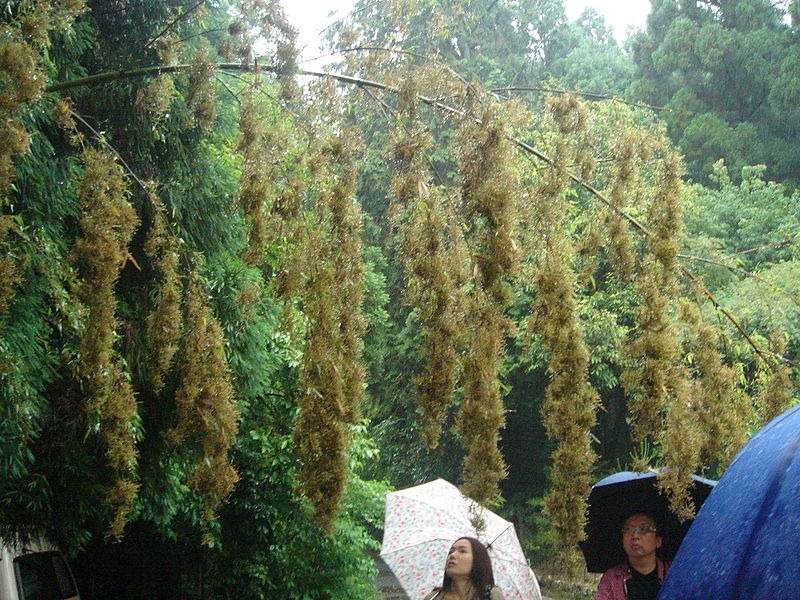Bamboos are the fastest-growing plants on Earth. A typical bamboo grows as much as 10 centimeter in a single day. Certain species grow up to a meter during the same period, or about 1 millimeter every 2 minutes. You can actually see the plant grow in front of your eyes. Most species of bamboo reach maturity in just 5 to 8 years. Compare this to other popular hard woods that barely grow an inch in a week. Trees such as oak, can take up to 120 years to reach maturity. But when it comes to flowering, bamboos are probably one of the slowest plants in the world.
The flowering of bamboos is an intriguing phenomenon, because it is a unique and very rare occurrence in the plant kingdom. Most bamboos flower once every 60 to 130 years. The long flowering intervals remain largely a mystery to many botanists.
Bamboo flowering in spring in a garden in Roskilde, Denmark. Photo credit
These slow flowering species exhibit another strange behavior — they flower all at the same time, all over the world, irrespective of geographic location and climate, as long as they were derived from the same mother plant. Most bamboos are exactly that — they are ‘division’ taken from the same mother plant at some point. These divisions were re-divided over time and shared across the world. Although the divisions are now geographically in different locations, they still carry the same genetic makeup. So when a bamboo plant in, say, North America flower, the same plant in Asia will do the same at roughly the same time. It is as if the plants carry an an internal clock ticking away until the preset alarm goes off simultaneously. This mass flowering phenomenon is called gregarious flowering.
According to one hypothesis, mass flowering increases the survival rate of the bamboo population. The hypothesis argues that by flooding the area with fruit, there will still be seeds left over even if predators eat their fill. By having a flowering cycle longer than the lifespan of the rodent predators, bamboos can regulate animal populations by causing starvation during the period between flowering events. The hypothesis still does not explain why the flowering cycle is 10 times longer than the lifespan of the local rodents.
Bamboo flowers and fruit. Photo credit
Once a bamboo species has reached its life expectancy, had flowered and produced seeds, the plant dies, wiping out entire swaths of forests over a several year period. One theory is that seed production requires an enormous amount of energy which stresses the bamboo plant to such an extent that they actually die. Another theory suggests that the mother plant dies to make room for the bamboo seedlings.
The mass flowering events also attract predators, mainly rodents. The sudden availability of fruits in huge quantities in the forest brings in a tens of millions of hungry rats who feed, grow and multiply at alarming rates. After they devour the bamboo fruit, the rats start consuming crops — both stored as well as on fields. A bamboo flowering event is almost always followed by famine and disease in nearby villages. In the northeastern India's state of Mizoram, the dreaded event occurs almost like clockwork every 48 to 50 years, when the bamboo species Melocanna baccifera flowers and fruits. The phenomenon, which occurred last in 2006 to 2008, is known in the local language as mautam or "bamboo death."
A black rat munches on corn in a field near Zamuang village in northeastern Mizoram. Photo credit
Children captures rats after a bamboo flowering season in Burma. Photo credit
The Fargesia nitida, in flower, once in 120 years. Photo credit

Bamboo flowering. Photo credit
Sources: Wikipedia / Bamboo Botanicals / Guadua Bamboo / Nat Geo

















had no idea they even produced flowers! learning something new everyday still
ReplyDeleteCan bamboo be grown in Tucson Arizona?
ReplyDeleteNo Greg, it cannot. Just be happy you guys have cacti down there.
DeleteMy bamboo has produced plumes like a pampas grass the first time in 20 years, they are beautiful
ReplyDelete